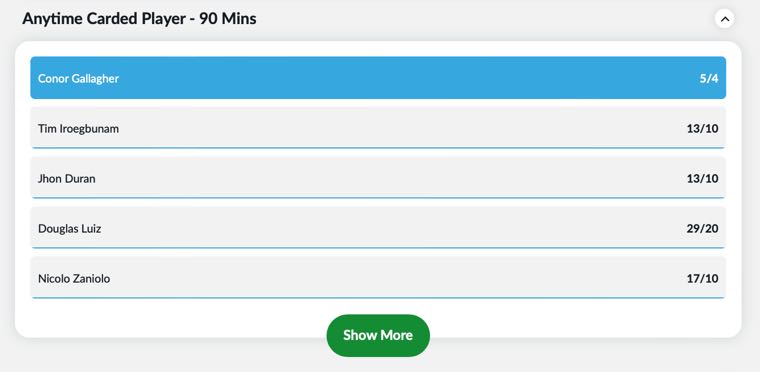 As mentioned in our piece about Corner Betting, there are a few markets that offer a little bit more value to them than some of the most popular lines out there. The vast majority of bettors will automatically look towards the likes of the 1X2 or Correct Score markets, but venturing into the world of Card Betting tends to be the reserve of the more expansive punter.
As mentioned in our piece about Corner Betting, there are a few markets that offer a little bit more value to them than some of the most popular lines out there. The vast majority of bettors will automatically look towards the likes of the 1X2 or Correct Score markets, but venturing into the world of Card Betting tends to be the reserve of the more expansive punter.
You can read elsewhere about Booking Points, which is obviously part of Card Betting but isn’t what we’re looking at here. Instead, this is more about the likes of Player to be Shown a Card and Cards Over/Under bets, which are good ones to add into an accumulator to add value.
Player to be Shown a Card

One of the most obvious examples of Card Betting is something that is also really easy to understand. The Player to be Shown a Card market does exactly what it says on the tin, offering you odds on a specific player to be shown either a yellow or red card. This market is only on the 90 minutes of the match plus any stoppage time that is played, so if your chosen player gets booked during a period of extra-time or a penalty shootout having not been booked in the match proper then it will be a losing bet. Here is how it looked when Arsenal played Bayern Munich is the second-leg of the Champions League in 2023-2024:
| Player | Odds |
|---|---|
| Aleksandar Pavlovic | 9/5 |
| Joshua Kimmich | 15/8 |
| Thomas Partey | 15/8 |
| Jorginho | 2/1 |
| Dayot Upamecano | 2/1 |
| Konrad Laimer | 21/10 |
| Matthijs de Ligt | 9/4 |
| William Saliba | 23/10 |
| Jakub Kiwior | 23/10 |
| Gabriel Jesus | 12/5 |
| Reiss Nelson | 9/2 |
That isn’t the entire list of players that the bookmakers offered odds on, but it gives you a sense of the sort of odds that you’re likely to get. Players that tend to be more combative will obviously have lower odds than those that are perceived to be more likely to avoid conflict in the game. If you’re placing the bet ahead of the teams being announced then you’ll often find that bookies put down virtually all of the names in a squad, even if the players are known to be injured or suspended. If the players that you’ve bet on don’t make it onto the pitch then don’t worry, your bet will usually be made void and your stake returned.
Red Card Markets

Whilst you will be paid out on the Player to be Shown a Card bet if you place a wager on someone and they’re shown a straight red card, there are other red card markets that you can bet on if you feel confident that there will be one but aren’t 100% sure which player will be send off. Here is how they often look:
| Market | Odds |
|---|---|
| Red Card in Match | 5/2 |
| Red Card in First-Half | 10/1 |
| Red Card in Second-Half | 16/5 |
| Home Team to Receive a Red Card | 5/1 |
| Away Team to Receive a Red Card | 5/1 |
| Both Teams to Receive a Red Card | 22/1 |
It is a way of betting on the red card market without the specificity of trying to work out which player will be shown a red card. As you can see, the fact that red cards are rarer also means that the odds are longer than the majority of the Player to be Shown a Card options, so if you do feel there’s likely to be a red card then it is the better market to place your bet on.
Cards Over/Under

Bookmakers love an Over/Under market, largely because there are plenty of variables in the outcome of it and the bet is decided definitively one way or the other. Here is a look at what it might appear as with the bookies:
| Over/Under Amount | Over Odds | Under Odds |
|---|---|---|
| 0.5 Cards | N/A | 66/1 |
| 1.5 Cards | N/A | 16/1 |
| 2.5 Cards | 1/25 | 7/1 |
| 3.5 Cards | 1/6 | 10/3 |
| 4.5 Cards | 1/2 | 11/8 |
| 5.5 Cards | 21/20 | 4/6 |
| 6.5 Cards | 11/5 | 2/7 |
| 7.5 Cards | 9/2 | 1/10 |
| 8.5 Cards | 8/1 | 1/50 |
There is plenty of information available out there on both how many cards teams tend to receive in matches and how many cards match referees tend to issue, so you can look into it to see which way a match is likely to go and then bet accordingly.
Team Card Betting

The final thing that it’s worth mentioning when it comes to Card Betting is that you can place wagers on a few markets around the teams. You can, for example, bet on the Team to Receive the Most Cards, which might look like this:
- Home Team – 6/5
- Away Team – 5/4
- Tie – 7/2
Alternatively, you can look at betting on the Home Team Total Cards or Away Team Total Cards, both of which are Over/Under markets and require you to work out whether the number of cards shown to each team will be Over or Under a certain figure chosen by the bookmaker.
